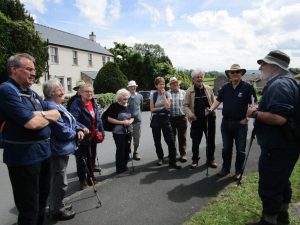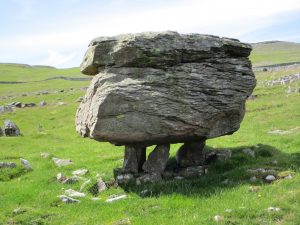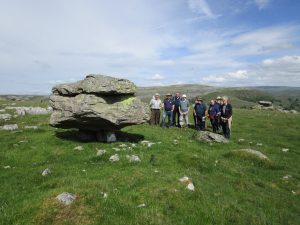Leader: Keith Waterson
Location and times: 3rd Tuesday @2pm in the Catholic Church Hall, Settle
As you travel around this “green and pleasant land”, or indeed the world, have you ever wondered why that hill is smooth and rounded, that one is stepped, another jagged? Even why there are hills in that direction and a valley or plain in another or why is that valley ‘U’ shaped and that one ‘V’ shaped? Why are different agricultural practises being followed as you move from one area to another or why is a village located where it is? The answer is often
GEOLOGY
16th July 2019 visit to outcrops of Bowland sandstone and shale and Pendle limestone
12 members visited a site called Water Fall Rock on the 25000 series map (SD 851 584) near Little Newton farm, Long Preston . The main exposure is a series of sandstone and shale bands forming part of the Lower Bowland shales. Nearby was an exposure of Pendleside limestone with a few crinoid fossils but it showed very little bedding even though the sandstone was dipping down at about 25 deg to the north west. On the walk in from Long Preston we viewed the drumlins and moraine that blocked the Ribble valley to form the glacial lake and eventually diverted the Ribble to the west whereas previously it had met the Aire and gone east. Evidence of the sand, pebbles and boulders forming the drumlins could be seen from the river terraces as we crossed the Long Preston Beck and followed the Newton Beck up from the farm. Small boulders of limestone and greywake were visible in the latter beck indicating the movement of the ice from further up the Ribble valley.
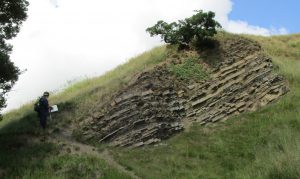
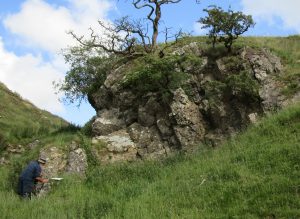
Lower Bowland shales Pendleside Limestone
18 June 2019 visit to Norber erratics and Crummackdale unconformity
12 members visited the erratics in Crummackdale and had an excellent afternoon crossing the erratics field and then looking at the Carboniferous/Ordivician unconformity before returning to Austwick.
Book List
This list was compiled by the late Paul Cochrane. MANY THANKS PAUL
Before we start, I am not envisaging anyone will want to read all these! The intention is to provide some ideas to cover all tastes and needs. The books in each section are NOT in any specific order.
GENERAL NOTES ON SELECTING BOOKS
- Be very wary of books on geology published before 1980. So many changes in thinking have occurred since the 1960’s renders older books rather misleading.
- Look for a good glossary – due to the rather fluid use people make of some geological terms, a glossary can be most useful.
- Always check there is an extensive index.
- When touring the country, look for local books on the scenery of the locality and its underlying geology. Not always too easy to find but invaluable when they are – especially when they provide walks which tend to identify exposures of the underlying geology, often difficult to find in an area with which you are not familiar, especially in non-coastal places.
- You may notice a bit of a theme in that the author Richard Fortey appears quite often. He was the Head of Palaeontology at the Natural History Museum, before his retirement, and I find all his books extremely well written in an easy jargon free style, comprehensive and full of fascinating anecdotes and insights.
GEOLOGY
- “Reading the Rocks: the autobiography of the Earth” (2006) Marcia Bjornerud – a well written account of the Earth’s history, chemistry, geological processes and the effects life has had on the story. Up-to-date, witty and very much written for the general reader – any jargon used is fully explained, in fact it could easily be described as a “jargon buster”.
- “The Hidden Landscape” (1993) Richard Fortey – the story of the rocks that underlie the whole UK. A journey through the country both physically and back through time.
- “Earth Story” (1998) Simon Lamb & David Singlton – BBC publication, it was an excellent television series presented by the biologist Aubrey Manning. Well written text with fantastic photographs and diagrams.
- “The Geology of Britain” (2000) Peter Toghill – great easy read, excellent introduction to geology with examples trawled from across the UK – simple and straight forward. Has a very simple one page glossary
- “Geological History of the British Isles” (2004) Arlene Hunter & Glynda Easterbrook – an Open University publication with a slightly more academic approach, but still very readable. Again very well illustrated. With a good glossary.
LANDSCAPE – a lot of these are rather old – possibly not so important re landscape. Also, this topic is not my forte; others in the group are probably better able to advice in this area.
- “Making of the English Landscape” (1955) W. G. Hoskins – the classic work on the subject.
- “Discovering Landscape in England and Wales” (1985) Andrew Goudie & Rita Gardener – and region by region study of interesting landforms, with an explanation of the underlying geology. Masses of photographs and clear diagrams.
- “Shell Guide to Reading the Landscape” (1984) Richard Muir – a great insight to understanding all the factors that contribute to making a landscape.
- “The Landscape Detective” (1986) Anthony Burton & John May – fascinating introductory chapter explaining “where to start” with the subject. The main body of the book consists of twelve walks, through different landscapes in the UK. One walk is around Skipton, tracing the town’s development from the Medieval, then out through Embsay to the moors.
- “Geology and Scenery in England and Wales” (1948 revised 1971) A.E. Trueman – a fascinating study, region by region, of the country. The landscape aspects of it are fantastic and some of the geology is okay but due to its publication pre the 60’s and some of the geology is out-of-date and misleading to say the least. Still an extremely worthwhile book.
PALAEONTOLOGY & FOSSILS
- “Fossils: the key to the past” (2002) Richard Fortey – excellent overview of the fossilisation process, some of the history of discoveries, the origins of life and evolution.
- “Life: an unauthorised biography” (1997) Richard Fortey – extremely interesting review of the entire subject.
- “The Story of Fossils: in search of vanished worlds” (1987) Yvette Gayrard-Vale– a short, extremely well illustrated history of palaeontology – from the myths and legends stage, through the early scientific discoveries to modern studies and methods today.
- “Fossils – the story of life” (1997) Sue Ridby – short but never the less great introduction with wonderful, simple illustrations. Published by British Geological Survey “Earthwise” series – see below.
- “Fossils – a very short introduction” (2005) Keith Thomson – one of a great series by Oxford University Press. An excellent overview of the topic in a short, well written book that covers all the essentials from the development of the study of fossils from the Greeks on, a detailed account of fossilisation processes – plus it covers much of the current thinking in palaeontology today.
LOCAL STUDIES
- “The Yorkshire Dales Landscape and Geology” (2007) Tony Waltham – comprehensive overview of the subject, mainly the geology, with forty some pages at the end about man’s use of and influence on the area. Very well illustrated with some great diagrams, many of which I’ve plagiarised for my talks!
- Yorkshire Rock – a journey through time (1996) Richard Bell – very short but never the less great introduction with wonderful, simple illustrations. There are a number of other excellent books from the British Geological Survey, both in this “Earthwise” series plus more technical publications and their geological maps – all available from their on-line shop http://shop.bgs.ac.uk/Bookshop/category.cfm?CAT_ID=1A
- “Geology of the Three Peaks” (1981) David Crutchley – a brief but detailed introduction, with suggested walks to view the features. Well illustrated.
- “Ingleborough Landscape and History” (2008) David Johnson – good overview of the geology, landform processes, archaeology and land use of the area.
- “Yorkshire Geology (2009) Paul Ensom – another well written and illustrated account of the subject covering the whole county, most of the earlier suggestions only cover The Dales.
- “Yorkshire Rocks and Landscape: a field guide” (1994 may be a later version) edited by Colin Scrutton – published by the Yorkshire Geological Society. Twenty-one excursions/walks covering the whole county with an excellent introduction telling the geological story of the area.
- ” Two other books, in the same format, take the story a little further a field.“Northumbrian Rocks and Landscape” (1995) again edited by Colin ScruttonYorkshire Geological Society and “Lakeland Rocks and Landscape” (1992) Mervyn Dodd et al. Cumberland Geological Society.
GENERAL REFERENCE WORKS
- “Geological Science” (2001) Andrew McLeish – an A level text, very easy style with good, clear, black and white illustrations. Excellent general reference work on all aspects of geology and palaeontology. Not for reading cover-to-cover much more for “dipping into” via the comprehensive index.
- ” A dictionary of Geology or Earth Science is always a good investment. I use the“The Penguin Dictionary of Geology” (1972) D. G. A. Whitten with J. R. V. Brooks – my copy is hopelessly out-of-date, there will have been a number of updates since – obviously more up-to-date but the format and number of illustrations has not improved the work. The Oxford Earth Science dictionary looks excellent too – possibly it is rather better than the Penguin one now and covering a wider range of subjects – meteorology, oceanography and the planetary sciences.
- ” Guides to Rocks and Fossils are very usefully. I use the “Hamlyn Guide to Minerals, Rocks and Fossils” (1993) W. R. Hamilton et al. – before each of the three sections there is a good, if very short, introduction to the topic. There are many other such works available and they are a great help with identification of finds. I think this one is a good example of the genre.
POSSIBLE ADDITIONS – in no particular order
- “Earth Time – exploring the deep past from Victorian England to the Grand Canyon” (2005) Douglas Paler – two parts in one volume – a journey from London to Snowdonia in the footsteps of William Smith and following Major Powell’s boat trip through the Grand Canyon. Throughout it introduces all the important figures and events in the development of geology. A longish read but there is lots information in this one book.
- “Plate Tectonics: An Insider’s History of the Modern Theory of the Earth” (2003) Naomi Oreskes – a great detailed overview of this vital topic. Not a short read but I feel it is worth the effort.
- “Supercontinent – ten billion years in the life of our planet” (2007) Ted Nield – the hypothesis of this is the Earth has a propensity for all the land to coalesce and form Supercontinents in a 500 million year cycle.
- “The Man Who Found Time: James Hutton and the Discovery of the Earth’s Antiquity” (2004) Jack Repcheck – a biography of one of the great geologists of the past, an Edinburgh man (1726-1797) – often referred to as “The Father of Geology” – he was one of the first to really define geological processes and identify the vast time scales involved.
- “The Dinosaur Hunters” (2000) Deborah Cadbury – as the title suggests, the story of the development of palaeontology in the Victorian period through the rather manic search and great rivalries of these dinosaurs hunters.
- “The Map that Changed the World” (2001) Simon Winchester – another biography of one of the greats – William Smith (1769-1839) a canal and mines surveyor who both created the first geological map of the UK and showed how fossils could be used to build a stratigraphy and apply relative dates to the rocks at different locations.
- “The Dating Game: One Man’s Search for the Age of the Earth” (2000) by Cherry Lewis – an interesting biography of Arthur Holmes, he was very much involved in Plate tectonics, before it become the excepted norm but even more importantly he improved the isotope dating of rocks to give use a truer picture of geological time – Absolute Dating, before this only the relative ages were understood.
